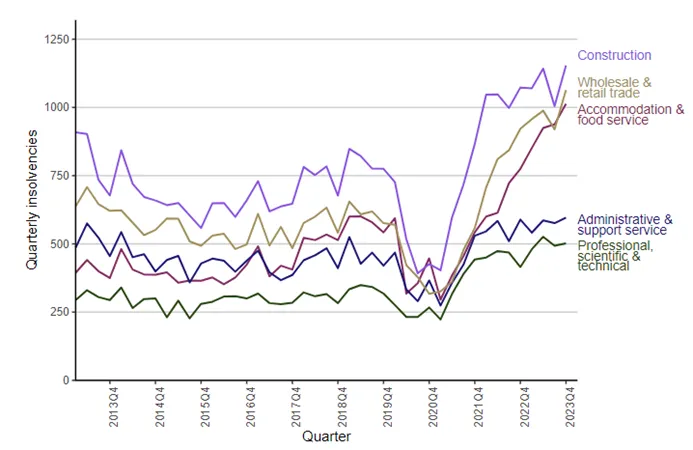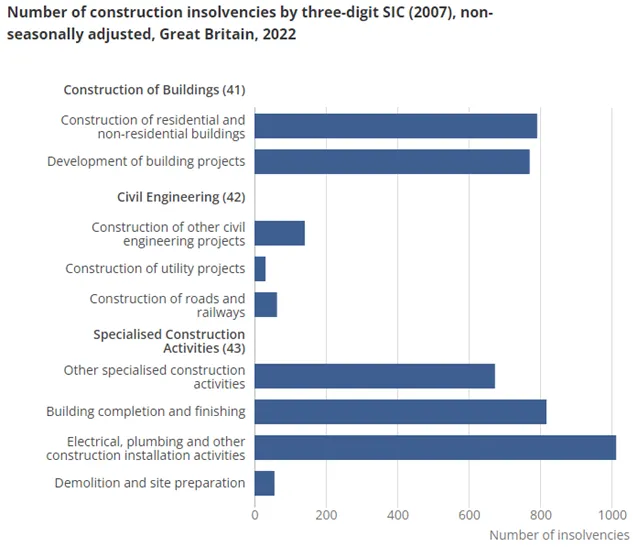
Insolvency in the construction industry: the macro issues
In our last but one article we covered the QS fundamentals relevant to project financial reporting. The final reflections in that article opened a wider consideration of financial issues faced by contracting businesses in the construction industry: this will be the focus of our next The science of Quantik® mini-series.
This first article of this mini-series will outline some relevant facts and issues about the wider issue of insolvencies in the construction industry. As usual, I will try to give you as much information as I can in a five-minute article so will cover some of the statistics and my thoughts on the macro reasons for insolvency in the construction industry.
The statistics
It won’t come as a shock or surprise to learn to learn that the construction industry has the highest number of insolvencies in any sector within the UK economy. According to The Insolvency Service, in 2023 alone, the construction industry suffered 4,371 insolvencies which was an average of more than 1,000 insolvencies per quarter.
When those statistics are analysed over the last 10 years (refer Figure 1) you will see that construction has consistently suffered the highest number of insolvencies in any sector within the UK economy. The quarterly insolvencies were approximately 750 per quarter through to 2019 and 2020 where they reduced to around 500 per quarter.

Figure 1
In years 2021, 2022 and 2023 the trend has increased with more than 1,000 insolvencies averaged each quarter in those years.
It is probably not controversial to claim that the decrease in 2019 and 2020 is likely to be owed to financial support offered by government during the COVID-19 global pandemic and the increase in insolvencies is caused by both the impact of COVID-19 and that financial support coming to an end.
Whilst this covers the trend over the last 3-4 years, it is evident that, even if those anomalies were normalised, we regularly have 750 construction businesses declaring insolvency each quarter and we are consistently the most financial unstable industry in the UK economy.
The Office of National Statistics (ONS) provides statistics which show the number of insolvencies by three-digit Standard Industrial Classification (SIC) in 2022 (Figure 2). Interestingly for mechanical and electrical (M&E), finishing trades, and main contractors in the building sector ranking high whilst civil engineering insolvency rates are relatively low.

Figure 2
Macro reasons
This is a complex area and no doubt, depending on who you ask, you would get a wide range of opinion about the reasons why.
It wouldn’t be sensible to cover all of these in a five-minute article so I am going to focus on two of the macro issues under which most of the opinion would be housed. These are that either there isn’t enough money available for constrruction businesses to deliver on expectations profitably (price point) and / or we are more wasteful than we should be with that money which causes an erosion of profit (productivity).
In both cases, these macros problems are wide ranging and multi-faceted but they both go to the root of cash flow problems which, ultimately, causes insolvency.
Price point
We suffer with procurement practices where the definition of value is either not described or is clumsily described, meaning that procurement choices default to a lowest price wins competition.
There aren’t many industries, in fact I can’t think of another, that operates a cost-plus margin pricing model. If you think about anything that you typically buy, the price point is driven by market forces. Either the product or service has become commoditised because supply is plentiful, or the product or service is valued by the customer to the extent that price can be held high.
It seems bizarre that we experience profitless booms in the construction industry. How can construction work be commoditised where there is so much demand? Should businesses in the construction sector hold on to more of the value they create by holding out for a fairer price? Do construction businesses give in too easily on price and risk profile in their pursuit of turnover and cash?
I guess the answer will depend on the circumstances, but there is certainly plenty to consider.
Productivity
My dear friend: construction productivity.
The statistics are there for everyone to see but, if you step back and think about it, have you ever had that feeling that your project is a well-oiled machine from top to bottom with everyone organised, coordinated and delivering productively?
The cash burden of low productivity (i.e. not performing the work at a cost commensurate with the production rate agreed in your sales rates) is immense. If you are delivering a major project, it is incredible how much money can be burnt each day, week and month. The cash comes in because you are over certified on measured works so your cash balance looks healthy, then you hit the cliff edge in the final third of a challenging project and watch that cash balance erode before your very eyes.
There is no doubt, in my mind, that the industry’s productivity performance is linked to its high rate of insolvencies: improvements in productivity may lead to reductions in insolvency rates.
Final reflections
I feel there is so much more I could say about this topic because there are so many factors which contribute to the construction industry’s high insolvency rates. I will refrain and, for the time being at least, leave it there.
Next week I will move onto giving you some insights about the highest profile construction casualty of the last 10 years: Carillion. I will outline some of the background to that catastrophic collapse and give some tips and advice about what could be done differently.
Look out for that one and, in the meantime, enjoy the rest of your week!
p.s. if anything in this article, or any of our articles, resonates with a challenge you are experiencing, check out our Bringing The science of Quantik® to you initiative where we offer a tailor-made session aimed at helping you tackle your project or business challenge. If it's easier, you can head straight to the form and provide some details.
Back to articles
THE SCIENCE OF QUANTIK™
Publications
We publish insights through our LinkedIn newsletter, titled “The science of Quantik”, which are light bites of information covering news and insights relating to the construction industry and quantity surveying.
LinkedIn